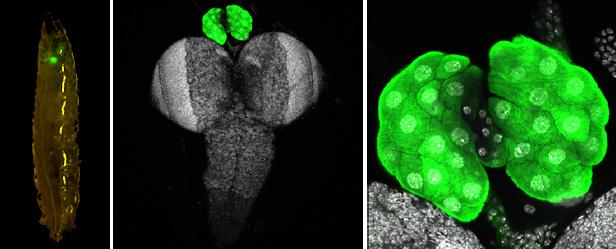

Image of a maggot (left); the steroid producing cells with the maggot brain (middle); and an expanded image of the steroid producing cells (right). Note large nuclei (dense white area) of steroid producing cells, which are labeled with a green fluorescent marker.
Credit: UC Riverside
Like humans, insects go through puberty. The process is known as metamorphosis. Examples include caterpillars turning into butterflies and maggots turning into flies.
But, it has been a long-standing mystery as to what internal mechanisms control how insects go through metamorphosis and why it is irreversible.
Now, a team of scientists, led by an assistant professor at the University of California, Riverside, has solved the mystery. They also believe the findings, which were just published in an early version in the journal PLOS Genetics, could be applied to mammals, including humans. The final version of the paper will be published Feb. 8.
Using the model organism fruit flies, the researchers found that the amount of DNA in the fruit fly controls the initial production of steroid hormones, which signal the start of metamorphosis.
More specifically, the cells that produce steroid hormones keep duplicating their DNA without cell division, making their nuclei huge. The team found that this amount of DNA in steroid hormone-producing cells is a critical indicator of their juvenile development, and it even determines when the insects get into metamorphosis.
Naoki Yamanaka, an assistant professor of entomology at UC Riverside, likened the accumulation of DNA to rings found inside trees that are used to date trees.
“The amount of DNA is like an internal timer for insect development,” Yamanaka said. “It tells the insect, 'OK, I will grow up now.'”
Their finding explains, for the first time, why insect metamorphosis, just like human puberty, is an irreversible process. It is irreversible since DNA duplication cannot be reversed in cells. Once the cells increase the amount of DNA and start producing steroid hormones, that is the point of no return; they cannot go back to their childhood.
The findings could have multiple applications. In the short term, they could be used to help control agricultural pests by manipulating their steroid signaling pathways. They could also be used to aid beneficial insects, such as bees.
In the long term, the findings could also be used to develop better ways to treat diseases in humans related to sexual maturation, since human puberty is also controlled by steroid hormones, just like insects. The results may also aide future studies on steroid-related diseases such as breast cancer, prostate cancer, and menopause-related symptoms.
Yamanaka will continue this research by focusing on other insects, such as bumblebees and mosquitos, to see if they have a similar internal timer.
###
The PLOS Genetics paper is called “Nutrient-Dependent Endocycling in Steroidogenic Tissue Dictates Timing of Metamorphosis in Drosophila melanogaster.”
In addition to Yamanaka, the co-authors are Yuya Ohhara, of the University of Shizuoka in Japan, who formerly worked in Yamanaka's lab at UC Riverside, and Satoru Kobayashi, of the University of Tsukuba in Japan.















